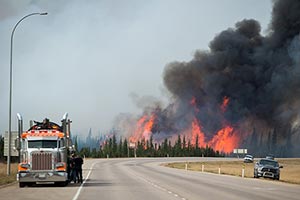Oil Trades Near $45 as Canada Wildfires Temper Global Surplus

Crude traded near $45 a barrel May 8 as Canadian wildfires knocked out about 1 million barrels a day of production, outweighing the new Saudi Arabian oil minister’s pledge to maintain the country’s policy of near-record output.
Futures were little changed after increasing as much as 2.9% in New York and 2.5% in London. The blaze has led to cuts equivalent to about 40% of Canada’s oil-sands production, based on IHS Energy estimates. Ali al-Naimi will be succeeded by Saudi Arabian Oil Co. Chairman Khalid Al-Falih, an ally of Prince Mohammed bin Salman, who has backed the nation’s policy of prioritizing market share over prices and insisted any output freeze must involve Iran.
Oil has rebounded after slumping to the lowest level since 2003 earlier this year amid signs the global oversupply will ease as U.S. output declines. While American production has dropped, the Organization of Petroleum Exporting Countries has boosted supply to more than 33 million barrels a day, underpinned by gains from Iran and Iraq.
“As the dust settles I think we will find it’s business as usual in Saudi Arabia, as Al-Falih is not going to step away from the mantra of market share over price,” said Ole Sloth Hansen, head of commodity strategy at Saxo Bank A/S in Copenhagen. “Canada has obviously overshadowed this event in the short term, considering the amount of oil being forced to stay below ground.”
Canadian oil-sands producers Suncor Energy Inc, the country’s biggest energy company, Phillips 66 and Statoil ASA have declared force majeure — a provision protecting companies from liability for contracts that go unfulfilled for reasons beyond their control — on supplies from the region.
While the fire approached Suncor’s operations, there was no damage as firefighters held the blaze southwest of the area and the company said it has begun planning the restart of production. Current weather conditions and forecasts show the fire moving east, away from the site, Suncor said. Cnooc Ltd.’s Nexen operations to the south of Fort McMurray have suffered “minor” damage, said Chad Morrison, a wildfire manager for the Alberta government.
Non-OPEC supply is poised to slip by about 700,000 barrels a day this year, while global demand is forecast to rise by about 1.2 million barrels daily, according to the International Energy Agency. Al-Falih, speaking in January at the World Economic Forum in Davos, indicated that Saudi Arabia plans to act vigorously to defend its market share and exports as the market re-balances.
“Saudi Arabia will maintain its stable petroleum policies,” Al-Falih said in a statement on May 8.
Oil-market news:
• China imported 32.58 million metric tons of oil in April, data from the Beijing-based General Administration of Customs showed on May 8. That’s equivalent to 7.96 million barrels a day, up 3.2% from the previous month and near a record 8.04 million in February.
• Speculators decreased their long positions in WTI by 3.8% for the week ended May 3, the most since February, according to data from the Commodity Futures Trading Commission.
• Hedge funds and other money managers cut bullish bets on Brent crude by 35,221 contracts in the week ended May 3, according to data from ICE Futures Europe.
• Once fires in Alberta are under control, the majority of oil sands mining projects can be back to normal production levels in about one week, Morgan Stanley said.




